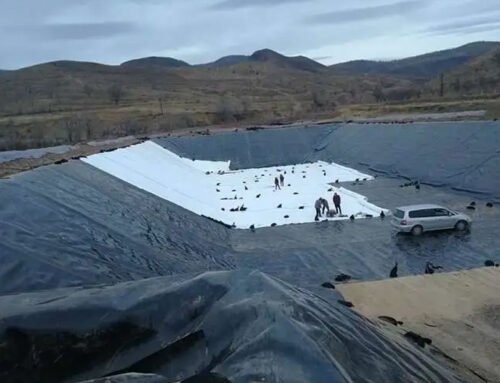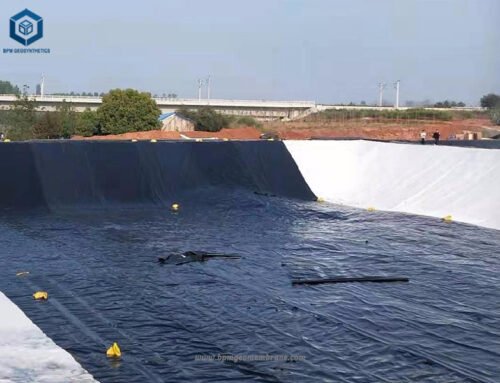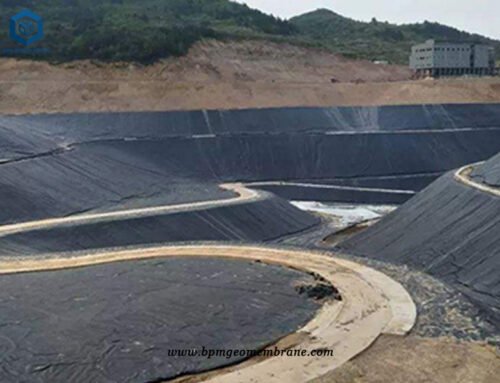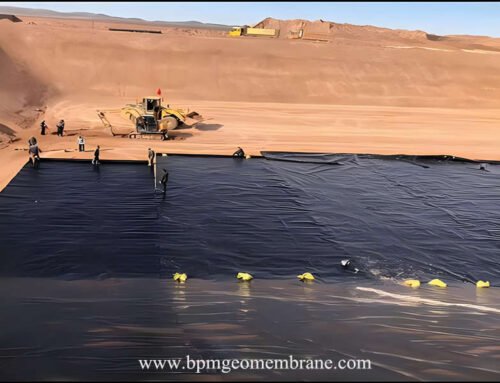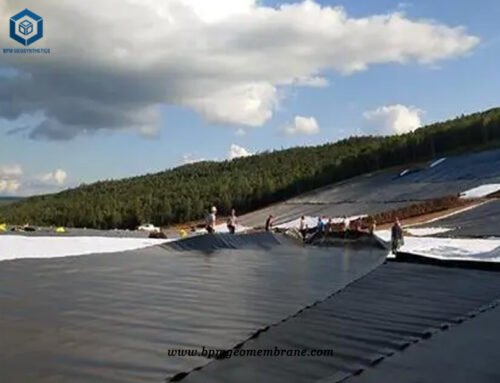HDPE circular pond liner, also known as HDPE Geomembrane Liner, is made of high polyethylene raw materials, adding 2%-3% of carbon black, anti-oxidation, anti-aging and anti-ultraviolet components, and is made by first-class automatic production equipment and three-layer pressing process. HDPE circular pond liner is an excellent product for larger applications requiring UV and ozone resistance, chemical resistance or high quality installation. HDPE geomembrane circular pond liner is a cost-effective option for exposed lining projects and are widely used in aquaculture, solid waste containment, mining, water containment applications and biogas digester projects.
1 What is HDPE Circular Pond Liner?
HDPE circular pond liner refers to a geomembrane liner made of High-Density Polyethylene (HDPE) specifically designed for circular or round-shaped ponds used in shrimp or fish farming projects.
In shrimp or fish farming, geomembrane pond liners play a crucial role in providing water containment, protection, and maintaining the overall health of the farm ponds. The HDPE geomembrane tank lining serves as the foundational element of the shrimp or fish farm, ensuring a reliable barrier between the water and the surrounding environment.
Circular pond liners offer several advantages for shrimp or fish farming applications. The circular shape allows for efficient use of space and facilitates better water circulation within the pond. This circulation can help maintain water quality, oxygen levels, and overall environmental conditions necessary for the healthy growth of shrimp or fish.
HDPE is a popular choice for pond liners due to its unique properties. It offers excellent resistance to UV radiation, chemicals, and punctures, ensuring long-term durability and protection against potential leaks. HDPE liners also have high tensile strength and flexibility, allowing them to adapt to the contours of the pond and withstand various environmental conditions.
By using HDPE circular pond liners, shrimp or fish farm operators can establish a secure and reliable containment system for their ponds. This helps to prevent water loss, maintain water quality, and create a suitable environment for the growth and development of shrimp or fish.
It is important to note that the selection and installation of an appropriate HDPE circular pond liner should be based on factors such as the size of the pond, water depth, soil conditions, and specific requirements of the shrimp or fish species being cultivated. Consulting with experts or suppliers experienced in shrimp or fish farming pond liners can provide valuable guidance to ensure the optimal performance of the liner system.
2 Case Study of HDPE Circular Pond Liner for Shrimp Pond Project in Ecuador
- Location:Ecuador
- Products:HDPE circular pond liner
- Application:Shrimp Pond in Ecuador


3 Why Chose HDPE Circular Pond Liner for Shrimp Pond Project in Ecuador
When considering a shrimp pond project in Ecuador, there are several reasons to choose HDPE circular pond liners:
- Soil Conditions: In coastal areas of Bangladesh, where shrimp farming is common, the land is often swampy, sandy, or comprised of organic soils. These types of soils are not suitable for traditional crop cultivation and can pose challenges for pond construction and maintenance. HDPE circular pond liners provide a reliable barrier between the pond water and the surrounding soil, preventing water loss and maintaining optimal conditions for shrimp growth.
- Acid Sulfate Soils: Some areas may contain pyrite, which can lead to low pH levels that are detrimental to shrimp farming. HDPE circular pond liners act as a protective layer, preventing the acidic soil from affecting the water quality in the pond and ensuring a suitable environment for shrimp cultivation.
- Water Retention: Sandy soils have poor water-holding capacity, making it difficult to maintain water levels in the ponds. HDPE circular pond liners prevent seepage and water loss, allowing for efficient water management and maintaining the desired water depth for shrimp farming.
- Stability and Oxygen Demand: Organic soils can be unstable and have a high oxygen demand. HDPE circular pond liners provide stability to the pond infrastructure, preventing erosion and maintaining the structural integrity of the pond. Additionally, the liners reduce oxygen demand, ensuring a healthier environment for shrimp while minimizing the risk of disease outbreaks.
- Drainage and Drying: Low-lying terrain in these areas can pose challenges for drainage and drying of ponds after harvest. HDPE circular pond liners facilitate effective drainage, allowing for proper water removal and drying of the pond bottom. This helps to maintain optimal pond conditions and prevent the deterioration of the pond bottom, reducing stress on the shrimp and minimizing the risk of diseases.
Our Ecuador customer left a message on social media Facebook telling us that he needed to purchase geomembrane for shrimp ponds and asked about the price of the product. In Bangladesh, shrimp farming is usually carried out in coastal areas because of the availability of brackish or seawater supply ponds. Also, the land is swampy or sandy, and sometimes organic soils may appear. Such land is not suitable for growing crops or plantations, and the price is relatively cheap. Such land is also used to build ponds, and ponds built in soils that contain pyrite (potentially acid sulfate or active acid sulfate soils) can create low pH levels, which can cause problems for shrimp farming. Ponds built in sandy soil do not hold water well. Organic soils do not allow stable dikes and have a high oxygen demand. Due to the low-lying terrain, shrimp ponds built in these areas face difficulties in drainage and drying after harvest. The bottom of the pond is not completely dry, and after a few prawns have been raised, the bottom of the pond can deteriorate, which can stress the prawns and facilitate disease outbreaks.
4 Solution of HDPE Circular Pond Liner for Shrimp Pond Project in Ecuador
The customer shrimp farming in Bangladesh encountered the above problem. After communicating with our company, we recommended the customer to use a 0.5mm geomembrane circular pond liner. This method separates the pond water from the soil. Due to its durable and unbreakable characteristics, HDPE circular pond liner not only effectively prevent weeds, sludge and other obstructive pollutants from entering the pond, but also reduce the bacteria in the pond environment, thereby reducing the use of antibiotics. In addition, geomembranes also protect pond slopes from erosion and are extremely convenient for servicing and quick removal of sediment and waste. We provided customers with 0.5mm geomembrane pond liner samples for testing. After receiving the samples for testing, the customer was very satisfied with the results. The customer purchased a 0.5mm geomembrane for use in a shrimp farming plant. Our team also provides customers with professional advice and guidance on the installation of geomembrane. During the installation process, we wholeheartedly considered the customer, gave the customer a detailed description of the specific steps of the installation, and reminded the customer to pay attention to three points:
(1) Before laying, the laying surface should be leveled and compacted, and sandbags or heavy objects should be prepared to prevent the laid HDPE geomembrane from being blown away by the wind.
(2) The slope of the breeding pond should not exceed 45°C, otherwise it is easy to collapse and it is not convenient for breeding.
(3) The anchoring ditch shall be dug into a U-shaped ditch or inverted trapezoidal ditch of 40cm-50cm, and then backfilled with soil.
5 Specifications of HDPE Circular Pond Liner Ecuador for Shrimp Pond Project
- Total HDPE Pond Liner Quantity – 111,720 square meters
- Thickness –0.5mm
- Roll Size -7m * 420m


6 Benifits of Circular Pond Liner for Shrimp Pond Project in Ecuador
(1) HDPE geomembranes in aquaculture are all made of high-quality new geomembrane special resins as raw materials. The production procedures are strictly controlled. Each roll of the manufactured products has been professionally tested, and all indicators have reached and exceeded international standards. environmentally friendly and non-toxic. The aquaculture film has the characteristics of tensile resistance, impact resistance, high tear resistance, and high resistance to hydrostatic pressure, and has the characteristics of acid and alkali corrosion resistance, anti-microbial erosion and good anti-seepage performance. The bottom of the pond or the pond can be completely separated from the pond water, which has a significant effect on anti-leakage, virus pollution, and anti-microbial erosion in the high and low shrimp ponds. Because the aquaculture membrane is smooth, it is not only convenient for disinfection and dredging, but also helps prevent the spread of pathogens at the bottom, shortens the time for cleaning the bottom of shrimp ponds and drying ponds, and can be stocked seven days after the drainage ditch, which can increase the number of shrimp farming and reduce shrimp farming. cost.
(2) The black color is opaque, which inhibits the growth of the grass at the bottom of the pool. There is no need to worry about the grass arching upwards and destroying the film. The black film can keep warm, increase the temperature of the water body, keep the water warm, and shorten the breeding cycle.
(3) The geomembrane has the dual functions of waterproofing and preventing the penetration of plant roots, which can withstand the puncture of plant roots and maintain the waterproof function for a long time. It can form a high-strength waterproof layer, which has strong resistance to pressurized water, and is resistant to puncture, tear and fatigue. Geomembrane is a flexible waterproof material with high impermeability coefficient and good heat resistance and cold resistance. Geomembrane has good chemical stability, can resist strong acid and alkali, and its high tensile strength can meet the needs of shrimp pond projects.
7 Summary
HDPE circular pond liners is the ideal geosynthetic material in shrimp pond projects, farmers can create a reliable and efficient containment system that promotes optimal shrimp growth and health. These HDPE liners provide a cost-effective solution that contributes to the sustainability and productivity of the shrimp farming industry.
PM has been specializing in delivering one stop geosynthetics products and solutions to worldwide customers since its foundation in 2007. BPM had provided many types of effective and state of the art geomembranes, geotextiles, geocells, geosynthetic clay liners (GCLs), drainage boards, geogrids to over 81 countries.
BPM Geomembrane is not only manufacturing best quality geosynthetic products but also providing professional design and installation service. OEM, ODM, custom development and fabrication are also available. If you have any questions or inquiries, please contact us, we will reply as soon as possible.

